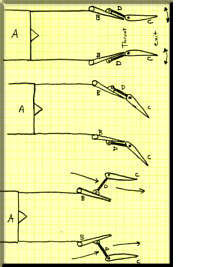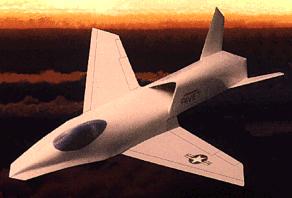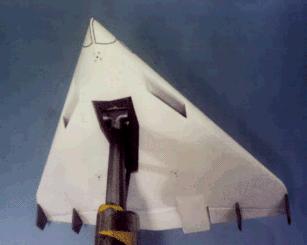By Dr. Daniel P. Raymer
For some reason, for most of my career I’ve been the one that gets the “nut letters” – from the guy who decides that the way to make flying saucers work involves rotating buckets of mercury. Or the serious engineer who steps out of his/her own discipline into a new world where the solutions are easy and the problems aren’t yet understood. Or, sometimes, someone who really has a new and potentially usable concept.
Maybe getting such “nut letters” says something about me – after all, I’m the guy with the patent for a jet aircraft with the engine mounted backwards (for VSTOL). Or, maybe the rest of the engineers think it’s funny to stick me with them. Actually, I enjoy seeing new thoughts – good or otherwise – but I do dread having to tell someone that their beloved brainchild isn’t going to work, or that it might work but probably not have enough benefit to be worth the trouble.
Often, though, such inventors are their own worst enemy. They fail to do a proper evaluation of their idea and then they fail even worse in presenting the idea in a manner that will be respected and understood by the working engineers who, ultimately, will make or break it. If you are a would-be inventor with an idea, read on. I’ll try to explain the right way and the wrong way to study and present an unusual aerospace engineering concept, without looking like another “nut”.

The right way is this:
- Really, really think about your concept. Exactly define the problem that you think it solves. Look for prior state-of-the-art, both to see if someone already thought of it and to learn more about similar concepts that compete with your new idea. The Internet is a good starting point, but also read new and old textbooks on the subject. Do a patent search. You may not like what you find, but better now than later. Examine the idea as a pessimist would – the bread really does fall butter-side down more often, you know! What could possibly go wrong in the application and use of your idea?
- Get all the data and numbers you can related to your idea. No matter how new the idea is, there is always some prior art that is relevant. Try to estimate the effects of your idea especially on the aerodynamics, propulsion, and weights of an aircraft, as well as on stability and control, subsystems, etc…
- Define an application that you think your idea best applies to. Turn that into a notional set of design requirements as if somebody is going to use your idea to meet a customer’s needs. These include payload weight, range, speed, takeoff and landing distance, climb performance, and others.
- From these requirements, design two aircraft – one with your idea, one without. Don’t cheat – make them both as good as possible. If you don’t have this expertise, hire it. The designs must look reasonable and buildable, or knowledgeable people will trash-can your idea without further ado. (My textbook “Aircraft Design: A Conceptual Approach” provides guidance on industry methods for aircraft design layout, analysis, and optimization.)
- Do a full, honest evaluation of both designs, using best estimates of the impacts of your new idea. Do not cheat, such as by putting composites or an advanced control system on the design with your idea, and not putting them in the other concept. Also don’t “stack the deck” by doing an optimized design with your idea, then simply removing your idea for the comparison concept. Do an optimized design for both.
- Do Growth Sensitivity Analysis for the concept with your idea showing the effect if your assumptions about your idea prove optimistic (it happens, you know!). Parametrically vary your assumptions in the appropriate areas, probably including weights, aerodynamics, and propulsion depending upon your idea. Calculate the impact of those changes on your aircraft’s sized weight, range, or performance (make graphs of percent change in assumptions vs. resulting impact).
- If the concept with your idea is materially better (say, 10-20% less weight or better performance), and the growth sensitivities aren’t too steep (say, a 20% worse assumption still gives a competitive design), then you may actually have something worth pursuing. And, now you have a comparison to show to other people.
- Prepare a technology maturation plan – everything that needs to be done from today forward to complete the engineering design and analysis, and to prove that the idea works. This should include a Risk Assessment – what problems may arise, how they will be addressed, and what the impact is on the concept. If you seek government funding you should probably use “Technology Readiness Level” terminology – identify what TRL your idea is at now, and show how you will mature it to TRL 6 or so, and eventually reach TRL=9.
- Now, go forth and beg – I mean, present your idea to potential investors and/or those who give study contracts for such things.
The wrong ways are many:
- Do not convince yourself that your idea has such unique characteristics that there is nothing to compare it to, and therefore you will skip steps 4 & 5 above. There is ALWAYS another way to meet a customer’s true needs.
- Don’t exaggerate current problems to make your “solution” seem better. Nobody knowledgeable is going to be fooled. Airplanes fly fine now, meeting customer needs at affordable costs.
- Don’t pile on – adding more and more “cool” ideas. Simplify your thinking down to the ONE unique thing you have invented. If it isn’t interesting enough without adding stuff, it isn’t interesting. If you have more than one unique idea, do not combine them unless each is impossible without the other. If you’ve invented a new propulsion concept, do not illustrate it in a wild-looking configuration concept that you’ve also just invented. In such a case, you have TWO ideas – pursue them separately.
- Don’t wrap your idea with the latest supporting technologies. Leave out the discussion of how much better your concept for a new type of tail will be when the design includes use of composites and GPS. We know, we know! The designers will use the best mix of affordable technologies for any new design – with or without your new idea. If your design MUST incorporate some other enabling technology, this is a disadvantage not an advantage. Use the enabling technology, but then allow the competing concept to use or not use it as appropriate.
- If you actually have a good idea, nothing will kill it faster than showing it in a naive or goofy aircraft concept. If you aren’t a skilled aircraft conceptual designer then either hire one or don’t even show a whole-vehicle concept.
- Remember, F=ma even for you. If you don’t have the skills to evaluate your idea based on sound science and engineering principles, then hire or persuade others to analyze it for you.
- Sometimes, “nut letter” ideas aren’t so bad and may actually “work”. However, that doesn’t automatically mean that they are better than the existing and understood way of doing things. You look silly if your final argument boils down to “let’s be advanced, even though there is no practical benefit.”
- And finally, please do not use the phrase, “They laughed at the Wright Brothers”. We’ve all heard it before. Remember, “they” laugh at everybody and usually “they” are right! There just aren’t that many great ideas laying around, undiscovered by those whose entire careers have been in a given area. If you want to convince knowledgeable people to invest time and money in your idea, first prove that your idea is workable and materially better than existing concepts using the steps outlined above. Then nobody will laugh.

Another issue that comes up – non-industry inventors are often excessively concerned about security and patents. One guy who contacted me wouldn’t talk about his concept over dinner because he was afraid the waiters would steal it. Sure, protect yourself with some reasonable non-disclosure agreement, but for the most part nobody is hovering around looking to steal your antigravity device. Frankly, knowledgeable people are more likely to automatically reject an invention concept than to try to steal it.
A final thought – don’t be discouraged by rejection, and also don’t be too encouraged by “non-rejection”. As to rejection – somebody else doesn’t like your idea, doesn’t believe it will work, or doesn’t think it has practical use. They may not have thought it all the way through, or they may be assessing it from a limited point of view, or they may just be suffering from the NIH syndrome (“not invented here”). So press on, if you are sure of yourself after an analysis such as described above.
On the other hand, just because some important person from industry, academia, or government is willing to meet with you and doesn’t throw you out, doesn’t mean that they really think the idea is a good one. They may just be polite. They may be saying, “ifyou can get it to work, we’d love to have a faster/better/cheaper airplane.” Of course they would, and that is not the same as saying “yes I think it will work!” Another possibility – they may be under instructions from their lawyers to avoid a clear rejection so that you don’t sue them for slander of your wonderful idea. It happens, and I was under such instructions while in industry. Finally, there is a tendency of experts in one area to ignorantly pontificate in other areas. Having a CFD expert’s endorsement of your new landing gear concept is really not all that useful, nor is a landing gear expert’s opinion of your new CFD code!

But don’t let me discourage you – press on, and good luck, fellow inventors!
Daniel P. Raymer